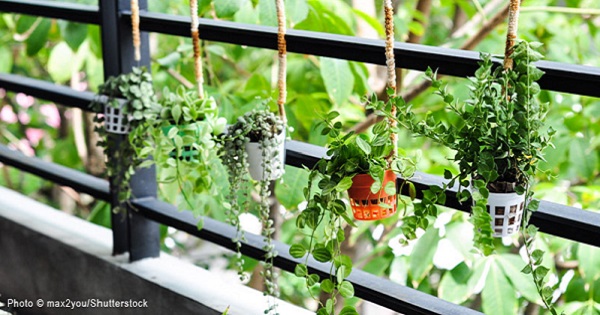|

Container Gardening How-Tos
By Wendy Priesnitz
No space for a garden? Don’t worry: Everything from salad greens and savory herbs to luscious fruits and vegetables can be as close as your patio, window box, balcony, or rooftop. Container gardening is the perfect solution.
Container gardening can be rewarding and satisfying. Working in a small space requires creativity and ingenuity. It appeals to many types of people – those with limited garden space, parents introducing young children to gardening, apartment-dwellers with only a balcony to grow on, disabled or elderly people who require high accessibility and low work, busy people who enjoy recreational gardening but who don’t have a lot of time, and novice gardeners who want to start small.
If it Holds Soil, it’s a Garden
With few exceptions – such as corn and pumpkins – everything edible that’s grown in a traditional garden can be raised in a container. Not enough time to garden? Except for the need for increased watering, container gardening is a lot less work than conventional gardening.
A container garden can often provide the ultimate in convenience, allowing a cook to have essential herbs close at hand. The mobility of container gardening also makes it easy to rearrange and resculpt your garden and to add new elements of interest and beauty.
You can grow plants in virtually anything that holds some soil and has holes in the bottom for drainage. We have seen old bathtubs, twenty-liter plastic containers with the tops cut off, baskets of various sizes lined with garbage bags to hold the water in, milk cartons for seedlings, old milk pails, even a discarded work boot!
The container’s size is dictated by the amount of space the plant’s roots will require. Shallow-rooted crops like lettuce, peppers, radishes, herbs, and most annuals are happiest in a container at least six inches in diameter with an eight-inch soil depth. Bushel baskets, half barrels, wooden tubs, or large pressed paper containers are ideal for growing tomatoes, squash, pole beans, cucumbers, and deep-rooted perennials.
Setting the container on a solid surface, such as a cement or patio floor, reduces drainage. Raising the container one or two inches off the floor by setting it on blocks of wood will solve this problem.
What Your Plants Need
A fairly lightweight soil mix is needed for container gardening. Dirt straight from the garden – especially if it has any clay – should not be used in a container because it is too heavy and holds too much moisture when wet, resulting in too little air for the roots. Please try to avoid using peat moss, which is unsustainable. Lime may be needed to bring the pH to around 6.5. In any case, a soil test is helpful in determining nutrient and pH needs, just as in a large garden. Add organic fertilizer such as bloodmeal, ground peanut cake, alfalfa meal, or bonemeal.
Nearly all vegetable plants will grow better in full sunlight than in shade. However, leafy crops such as lettuce, cabbage, greens, spinach, and parsley can tolerate more shade than root crops such as radishes, beets, turnips, and onions. The root vegetables can stand more shade than those which bear fruit, such as cucumbers, peppers, tomatoes, and eggplant. One advantage to container gardening is mobility. You can position vegetables in areas where they can receive the best possible growing conditions. Or put the pots on a cart or wagon and move them around to follow the sun!
Planting decorative containers is a fun and creative experience. Use several varieties of flowers and foliages in pleasing combinations of color and texture, even combining flowers with food plants that have attractive foliage.
Design the container gardening plantings for shade or sun, combining only those flowers that have similar cultural requirements. Include plants for height (e.g., Shasta daisies or rosemary), plants for spread (e.g., petunias), and plants to grow down over the edges of the containers, like trailing herbs and plants with attractive flowers, such as hanging fuchsias and verbena.
Plant too much rather than too little. Err on the side of extra plants for a lush, full effect. But to compensate for extra plants, fertilize and water abundantly.
Looking After Your Portable Garden
Pay particular attention to watering your container gardening plants. Because the volume of soil is relatively small, containers can dry out very quickly, especially if they are small and located on a concrete patio in full sunlight. Daily or twice-daily watering may be necessary. Apply water until it runs out the drainage holes.
Water clay pots and other porous containers more frequently, as they allow additional evaporation through the sides of the pots. If the soil appears to be getting excessively dry (plants wilting every day is one sign), try grouping the containers together so that the foliage creates a canopy to help shade the soil and keep it cool.
Check containers at least once a day and twice on hot, dry or windy days. Feel the soil to determine whether it is damp. Mulching and windbreaks can help reduce water requirements for containers.
Liquid seaweed emulsion is one of the best sources of micronutrients and a real soil and plant health booster. Use some in the watering can every two weeks.
Then, sit back, watch your plants grow, and reap your container gardening harvest.
Wendy Priesnitz is Natural Life Magazine's editor.
|

